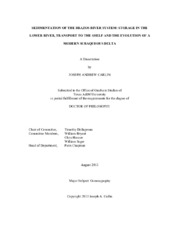| dc.description.abstract | The Brazos River, located predominantly within the state of Texas, has the highest water and sediment discharge of all rivers in the state, and ranks second behind the Mississippi River in terms of sediment load delivered to the Gulf of Mexico. This river is the only Texas river that consistently drains directly into the Gulf of Mexico forming a wave-dominated delta. The delta has experienced dramatic and rapid changes over the last 100-plus years. These changes have resulted from both natural and anthropogenic alterations to the coastal zone proximal to the river mouth and within the rivers watershed. By utilizing high-resolution geophysical data, sediment cores, water column data, and historic shoreline data this study investigated the mechanisms in which sediment is transported to the coastal ocean, the fate of that sediment as it becomes preserved in the modern geological record, and the evolution of a modern delta.
Results from this study show that during for a majority of the time a salt-water intrusion in the lower river traps sediment, preventing export to the coastal ocean. The trapped sediment forms an ephemeral mud layer in the lower river that may be remobilized during increased river discharges. When river discharges increase above an observed threshold of 300 m^3/s the salt wedge is pushed seaward of the river mouth and sediment is exported via a buoyant plume. As export of sediment is episodic, accumulation of sediment on the subaqueous delta characterized as non steady-state, and resembles typical foreset delta attributes. These include physical stratification of sediment layers, episodic but relatively high rates of accumulation, and little bioturbation. Currently sediment is primarily accumulating west of the river mouth, and the majority of sediment is bypassing the system. Over the history of the delta, changes both anthropogenic and natural have shifted the relative balance of fluvial sediment supply and marine sediment dispersal. These changes have resulted in dramatic changes in the shoreline, and phases of activation and abandonment of deltaic lobes, which can be seen through historical data and imagery, and is preserved in the recent sedimentary record. | en |


